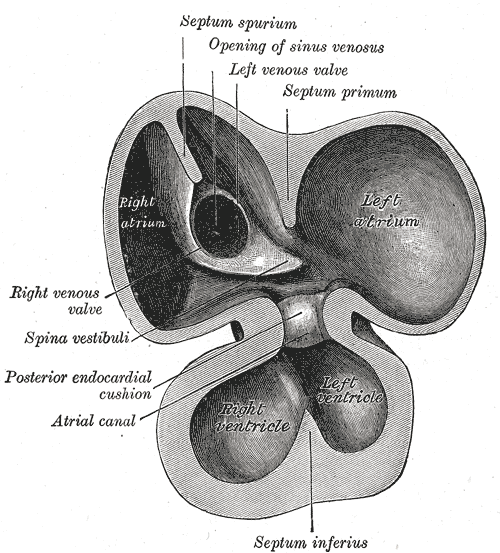Atrial septal defect ostium primum anatomy: Difference between revisions
Jump to navigation
Jump to search
No edit summary |
No edit summary |
||
| Line 11: | Line 11: | ||
[[Image:Gray465.png|350px|Interior of dorsal half of [[heart]] from a human [[embryo]] of about thirty days. (Ostium primum visible below [[septum primum]], but not labeled]] | [[Image:Gray465.png|350px|Interior of dorsal half of [[heart]] from a human [[embryo]] of about thirty days. (Ostium primum visible below [[septum primum]], but not labeled]] | ||
[[Image:Ostium primum.jpg|400px|thumb|Ostium Primum is the second most common type and is located in the lower portion of the atrial septum. This type often have a mitral valve defect associated with it called a mitral valve cleft. A mitral valve cleft is a slit-like or elongated hole in anterior leaflet]] | [[Image:Ostium primum.jpg|400px|thumb|right|Ostium Primum is the second most common type and is located in the lower portion of the atrial septum. This type often have a mitral valve defect associated with it called a mitral valve cleft. A mitral valve cleft is a slit-like or elongated hole in anterior leaflet]] | ||
* It occurs from the '''failure of fusion of the septum primum with the endocardial cushion'''. | * It occurs from the '''failure of fusion of the septum primum with the endocardial cushion'''. | ||
Revision as of 19:46, 2 October 2012
|
Atrial Septal Defect Microchapters | |
|
Treatment | |
|---|---|
|
Surgery | |
|
| |
|
Special Scenarios | |
|
Case Studies | |
|
Atrial septal defect ostium primum anatomy On the Web | |
|
American Roentgen Ray Society Images of Atrial septal defect ostium primum anatomy | |
|
Risk calculators and risk factors for Atrial septal defect ostium primum anatomy | |
Editor-In-Chief: C. Michael Gibson, M.S., M.D. [1]; Associate Editor(s)-In-Chief: Priyamvada Singh, M.B.B.S. [2]; Cafer Zorkun, M.D., Ph.D. [3]; Assistant Editor(s)-In-Chief: Kristin Feeney, B.S. [4]
For a full discussion on ostium primum defects click here.
Overview
Ostium primum defects usually occur due to the failure in fusion of the septum primum with the endocardial cushion.
Anatomy of an Ostium Primum Defect

- It occurs from the failure of fusion of the septum primum with the endocardial cushion.
- The endocardial cushion, is the portion of the heart where the atrial septum meets the ventricular septum and the mitral valve meets the tricuspid valve.
- Due to this, these defects commonly occurs in association with other cardiac anomalies such as atrioventricular valves (the mitral valve and the tricuspid valve).
- The abnormalities of the atrioventricular valves include the cleft mitral valve, and the single atrioventricular valve (a single large, deformed valve that flows into both the right ventricle and the left ventricle).
- These are usually large sized defects when compared to the secundum defects
- Endocardial cushion defects are the most common congenital heart defect that is associated with Down's syndrome.
